LEED-ND: why it matters, where it stands, and why enviros need to pay attention

Posted February 11, 2009 at 4:47PM
As I suspect most readers of this blog already know, NRDC has been one of the founding partners in LEED for Neighborhood Development, the national program to rate and certify smart growth projects. (The other two lead partners are the US Green Building Council and the Congress for the New Urbanism.)
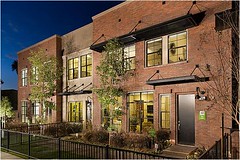 I've always seen NRDC's role as representational, being the voice of the smart growth and environmental constituency (our partners are mostly private sector), and we have an agreement with the Smart Growth America coalition to coordinate with them as we go along. NRDC happened to be the group with the initiative and capacity to get LEED-ND off the ground, but we make an effort to involve as many of our fellow travelers as possible. We know that the success of the initiative depends on the support of our broader movement. Currently the Sierra Club and Smart Growth America are both making huge contributions, and in the past Defenders of Wildlife and several local groups have done the same.
I've always seen NRDC's role as representational, being the voice of the smart growth and environmental constituency (our partners are mostly private sector), and we have an agreement with the Smart Growth America coalition to coordinate with them as we go along. NRDC happened to be the group with the initiative and capacity to get LEED-ND off the ground, but we make an effort to involve as many of our fellow travelers as possible. We know that the success of the initiative depends on the support of our broader movement. Currently the Sierra Club and Smart Growth America are both making huge contributions, and in the past Defenders of Wildlife and several local groups have done the same.
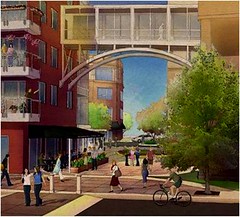 Right now we're in the pilot program, with over 200 planned and existing developments participating from around the country. At my last count, the first 21 have been certified. See this post for images of some of them - move the cursor over the pictures and you'll see their names, locations, and certification levels (basic, silver, gold, platinum). Most of the participants in the pilot are still assembling their documentation and have not been fully rated yet.
Right now we're in the pilot program, with over 200 planned and existing developments participating from around the country. At my last count, the first 21 have been certified. See this post for images of some of them - move the cursor over the pictures and you'll see their names, locations, and certification levels (basic, silver, gold, platinum). Most of the participants in the pilot are still assembling their documentation and have not been fully rated yet.
But we are quickly setting the stage for a move later this year from the pilot to full-scale, anyone-can-apply launch. Last fall we published a set of comprehensive revised standards for public comment, and received 5000 comments as a result. We (the core committee, appointed by the partners) are now pursuing further revisions as a result of the comments.
 Potentially, LEED-ND is a big deal: LEED for green buildings has been hugely influential in the marketplace, and one can even make a case that it is becoming the de facto law of the land, as two federal agencies, 22 states, and 75 municipalities have all given it legal standing one way or another. If LEED-ND follows a similar trajectory, the content of the standards by which development will be measured has huge consequences, and so do the checks and balances within the program that administers those standards.
Potentially, LEED-ND is a big deal: LEED for green buildings has been hugely influential in the marketplace, and one can even make a case that it is becoming the de facto law of the land, as two federal agencies, 22 states, and 75 municipalities have all given it legal standing one way or another. If LEED-ND follows a similar trajectory, the content of the standards by which development will be measured has huge consequences, and so do the checks and balances within the program that administers those standards.
That's the whole idea, really, and the reason why we at NRDC have been involved. That's the impact we want. But it does create enormous pressure to get it right.  If the standards are good, then truly smart and green projects will find favor with local approving agencies, even without statutory preferences. But if the standards are weak, then not-so-smart, not-so-green projects will find that same favor, and bad projects will get legitimized.
If the standards are good, then truly smart and green projects will find favor with local approving agencies, even without statutory preferences. But if the standards are weak, then not-so-smart, not-so-green projects will find that same favor, and bad projects will get legitimized.
So far, I think we're doing OK. The impact of the program is shaping up to be far more good than bad. Of the few projects that have gone all the way to certification, all but two or three are very worthy in my opinion, 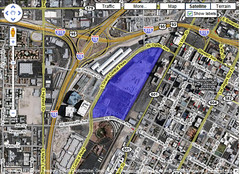 and we have tried to adjust the standards in response to the ones that weren't. But here are some of the issues that keep me awake at night:
and we have tried to adjust the standards in response to the ones that weren't. But here are some of the issues that keep me awake at night:
- Minimum standards for location. If we lose these, we might as well not have smart growth certification at all. But the overwhelming majority of public comments have come from developers and their affiliates, and there is a vocal (if minority) contingent that takes the position that sprawl is going to occur anyway, so we might as well try to influence it and make it 20 percent better, as if that's something to be proud of. I've made my views on that known already.
- Wetlands. One commenter said, and I'm not paraphrasing much, "what's so special about a wetland? This is urbanism we're talking about."
- Prime farmland. Our standards to protect farmland from permanent conversion are pretty weak already.
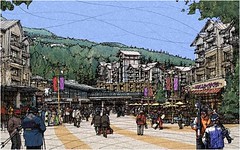 Density minimum. Right now our minimum is pretty minimal, at 7 units per acre for residential and 0.5 floor/area ratio for commercial. (We give credit points for higher levels.) But not minimal enough for some folks, apparently.
Density minimum. Right now our minimum is pretty minimal, at 7 units per acre for residential and 0.5 floor/area ratio for commercial. (We give credit points for higher levels.) But not minimal enough for some folks, apparently.- Weak participation from the smart growth world. I'm not unsympathetic: we're all overworked, the interface on the Green Building Council's commenting form is user-unfriendly, and the standards can get highly technical. But be warned: that's not stopping the developers and their friends.
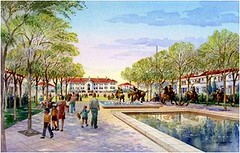 Remember, this isn't about what can be built and what can't. It's about defining what will be honored with the label of smart growth. That needs to mean something.
Remember, this isn't about what can be built and what can't. It's about defining what will be honored with the label of smart growth. That needs to mean something.
Enough fretting. Like I said earlier, this program is way more good than bad. All who have helped with it (and you know who you are) can take some pride in the accomplishment so far and the path that we are on. But the details matter. There will be another public comment period this spring when we publish the next revisions, and I hope you will make your opinions known.